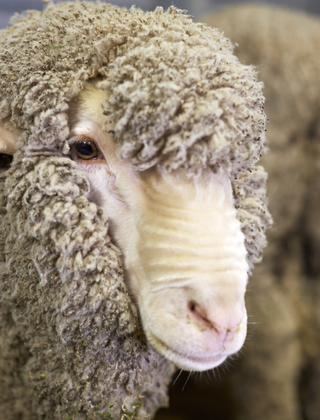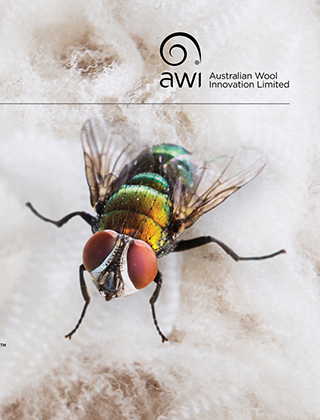Use the NWD to attract the highest price
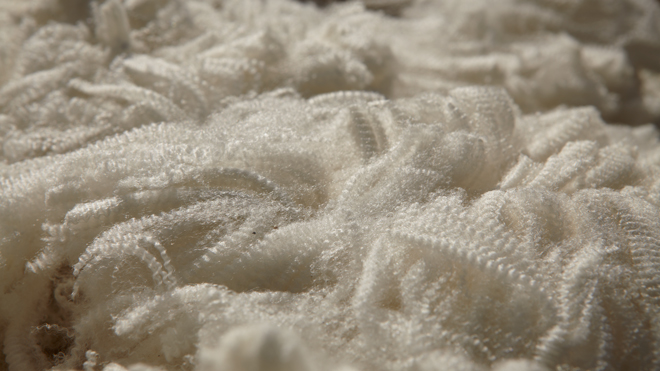
All woolgrowers are being urged to complete the National Wool Declaration (NWD), as wool sold as Not Declared usually receives a discount. The NWD provides transparency to buyers and the whole supply chain and helps woolgrowers earn Premiums and/or avoid Discounts for their wool.
Key messages
- To attract the highest price for their wool, all woolgrowers, regardless of their mulesing status or wool type, should ensure that their wool is accompanied by an NWD. Failure to complete an NWD has usually resulted in the wool being discounted.
- The NWD declaration rate has increased by 2.0 percentage points from 73.6% in 2022/23 to 75.6% in 2023/24. The NWD declaration rate for Merino wool has increased by 1.9 percentage points to 78.8%.
- Declaration rates for Non Mulesed (NM) wool continue to steadily climb (currently 21.5% of all wool; 15.3% of Merino wool), as do the rates for Mulesed with Analgesic/Anaesthetic (AA) wool (currently 43.0% of all wool; 50.9% of Merino wool).
- Remember to sign and date your NWD, otherwise the Mulesing Status of your mobs/lines of wool will not be shown on the sale catalogue and test certificate, which can reduce the number of buyers bidding on your wool, as well as the price you receive. Note, eSpecis can be electronically signed.
The National Wool Declaration (NWD) enables woolgrowers to communicate directly with prospective buyers, processors and retailers; and them send key wool market messages back to woolgrowers.
Whenever AWI discusses the Australian wool industry’s animal welfare with brands and retailers along the supply chain, they invariably say that they would very much like all Australian woolgrowers to declare their wool through the NWD; it creates two-way transparency and choice in the marketplace.
Once a woolgrower has completed the NWD, which is voluntary, the contents are converted for inclusion in sale catalogues and test certificates. All woolgrowers are encouraged to complete the NWD, regardless of their sheep’s breed and wool type, and husbandry practices.
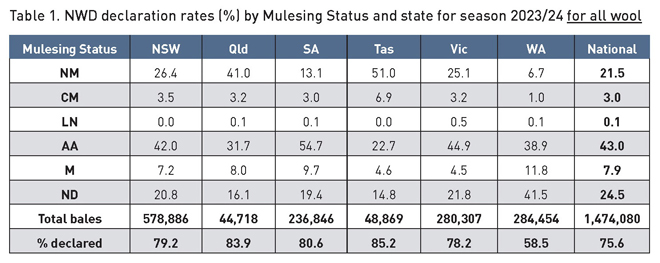
With the exception of Queensland, all states improved their declaration rate for the 2023/24 season. Table 1 shows that Tasmanian woolgrowers top the list for declaration rates at 85.2% of wool sold in 2023/24 followed by Queensland woolgrowers at 83.9%. The eastern states averaged close to 79.6% wool declared. The WA declaration rate is gathering pace with the biggest increase of any state since 2022/23 (up 4.3 percentage points) but it still has opportunity to improve.
Tasmanian and Queensland woolgrowers also top the NM categories at 51.0% and 41.0% of wool sold (which has been the case for a long time). These two states have the most NM wool as the risk of flystrike is lower; the expression of wrinkle tends to be lower in these environments, the weather in Tasmania is relatively cooler and windy and Queensland is hotter resulting in shorter fly seasons.
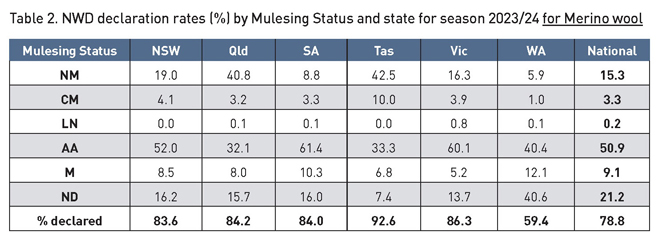
Merino wool declaration rates continue to improve across most states and categories. The message to declare is being heard and industry support is evident. Table 2 shows that the Tasmanian declaration rate (Merino) continues to lead all states at 92.6%.
Compared to the previous season, the national Merino clip declared as NM rose to 15.3% (up 7.5% YoY). All states increased their NM declaration rate (Merino), with Tasmania now the highest rate at 42.5%, followed by Queensland at 40.8%. The state with the biggest annual increase in NM declarations (Merino) was Victoria which rose by 14.0% YoY to 16.3%, followed by Tasmania up 12.1% YoY to 42.5% and South Australia up 10.0% YoY to 8.8%. Nationally, there was 4.9% YoY growth in AA declarations (Merino) to 50.9%, with South Australia now at 61.4%, Victoria at 60.1% and NSW at 52.0%.
Mulesed (M) declarations (Merino) have reduced by 11.9% YoY nationally, with the biggest YoY decreases in NSW (26.7%) followed by Victoria (20.0%). These two states are the largest wool producing states in Australia.
The WA declaration (Merino) rates have increased 8.6% YoY to 59.4%, but remains well behind all states by a minimum of 24.2 percentage points (NSW 83.6%). With an ND rate of 40.6%, WA has the greatest opportunity to improve.
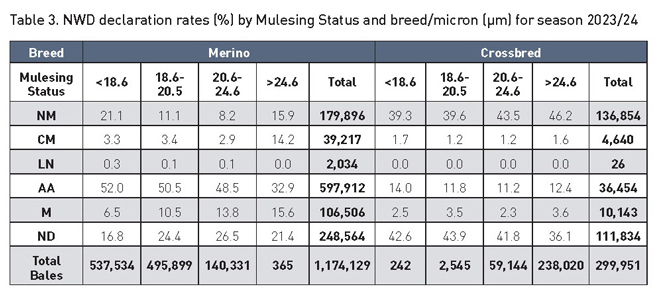
Table 3 shows that Merino breeders with lower micron wool, less than 18.6 microns, are most likely to declare, with only 16.8% of their wool sold not declared. By breed, the declaration rate for Merinos is 78.8%, whilst the Crossbred declaration rate is 62.7%; this appears to be a reflection of market prices as indicated in the Premium and Discount report in Table 4.
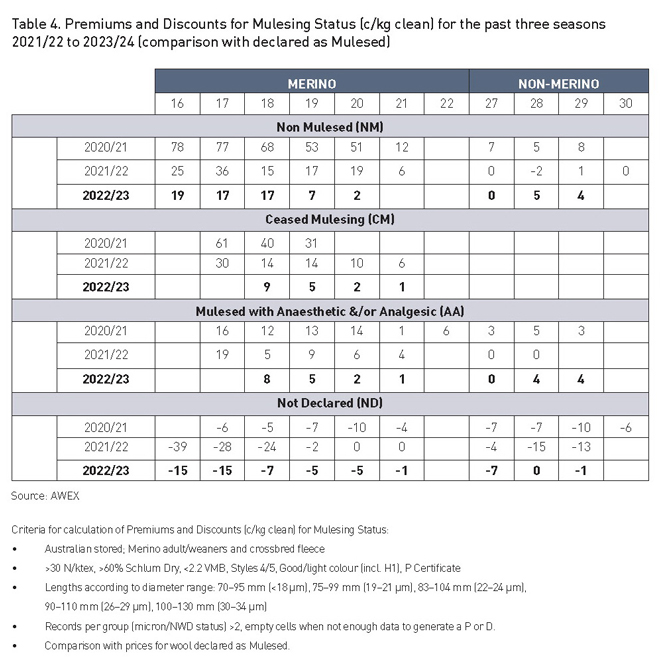
From a financial perspective, Table 4 shows that woolgrowers usually receive premiums for wool declared as NM or AA. This is a greater issue for WA woolgrowers as their declaration rate is 58.5%, lower than all the other states that range from 78.2% to 85.2% wool declared.
Given the subdued market during the year, the price incentives are more conservative than previous years. This reflects the relative demand for wool through the supply chain. (Note the AWEX data does not include wool sold direct from woolgrowers to wool buyers.)
Wool sold as ND usually receives a Discount compared to wool that is declared as M. These are the averages over the selling year and if you do mules, it would likely be financially advantageous for you to complete the NWD and declare your wool as M, rather than not complete the NWD.
The message is clear. To ensure your wool attracts the highest price possible, you need to ensure that your wool for auction is accompanied by an NWD.
For further advice on achieving Premiums for your wool, contact your wool broker.
Don't let your Declaration be wasted!
If you don’t sign and date your NWD, the Mulesing Status of your mobs/lines of wool will not be shown on the sale catalogue and test certificate. This can reduce the number of buyers bidding on your wool, as well as the price you receive.
To ensure the Mulesing Status of your wool is known by potential buyers prior to sale, sign and date the NWD.
It is good practice for owner/managers to talk to the wool classer at the start of shearing to detail all mobs and to sign/date the declaration. Note, eSpecis can be electronically signed.
More information: www.awex.com.au/market-information/mulesing-status/
This article appeared in the September 2024 edition of AWI’s Beyond the Bale magazine. Reproduction of the article is encouraged.






